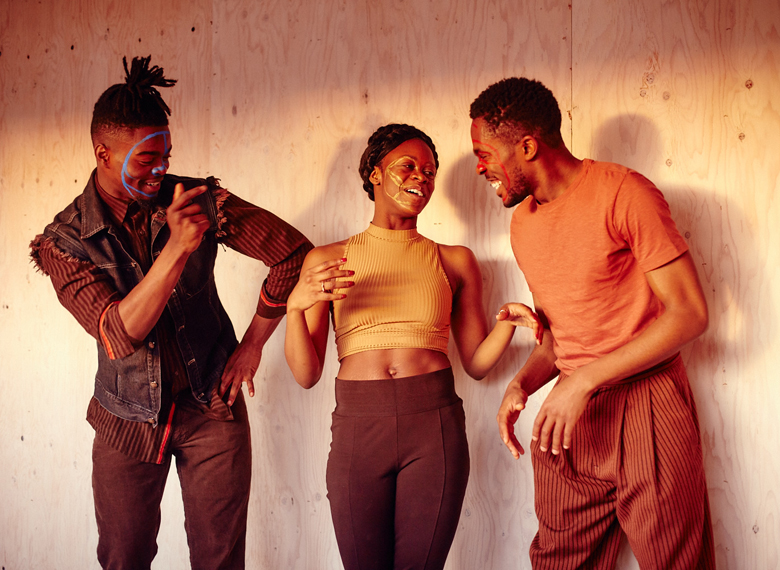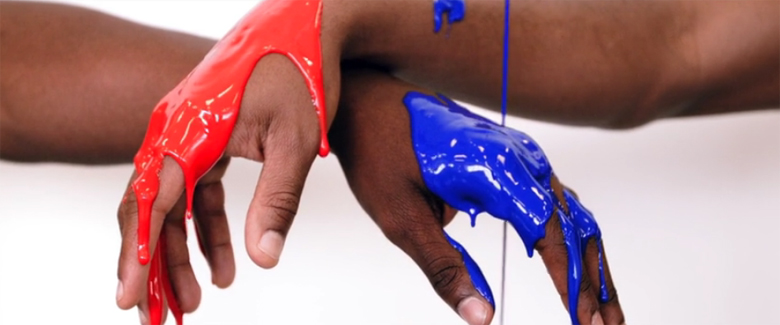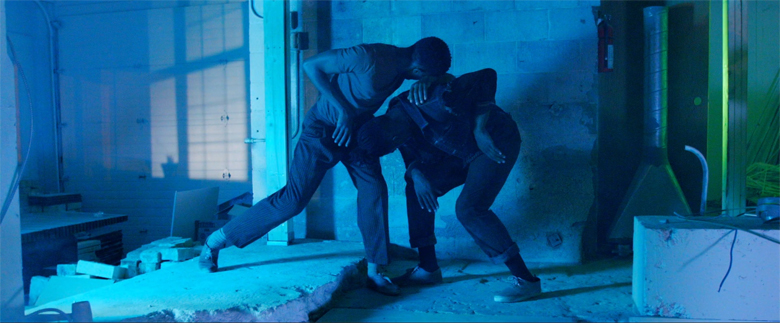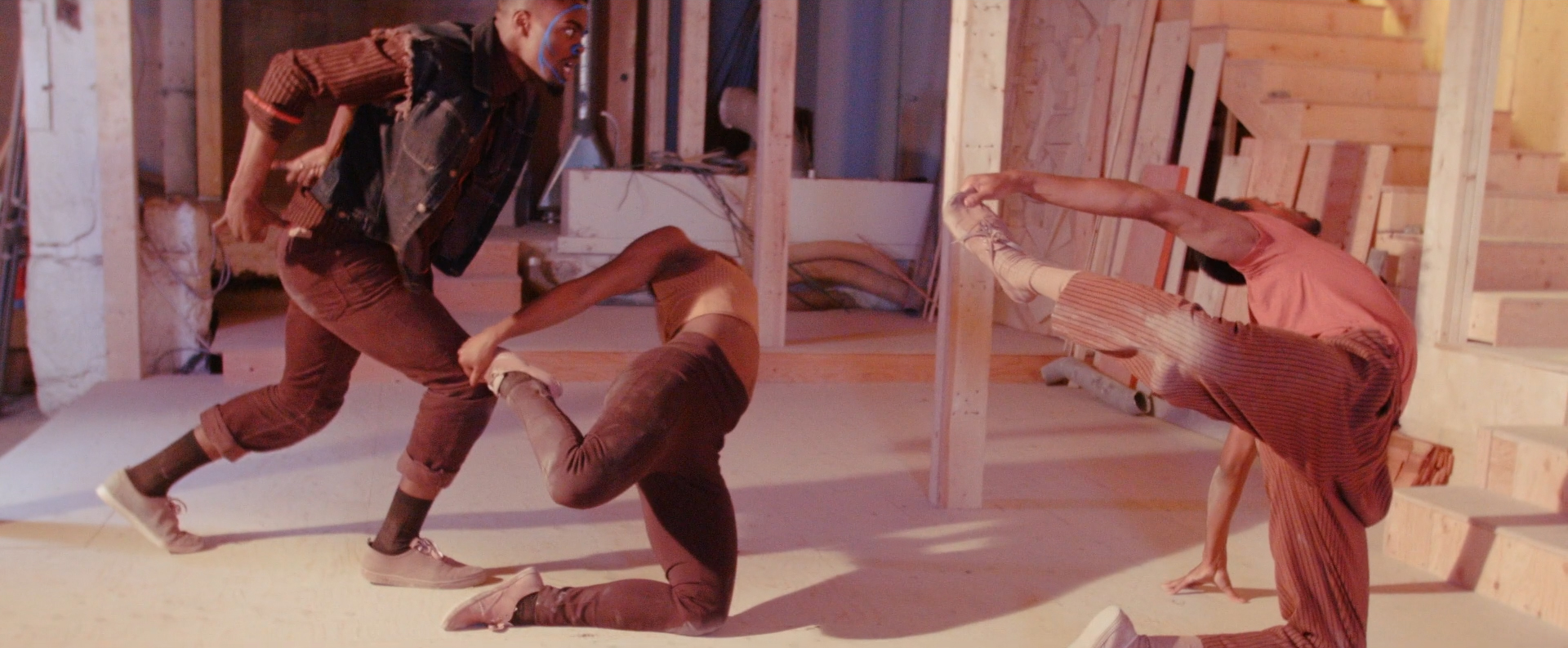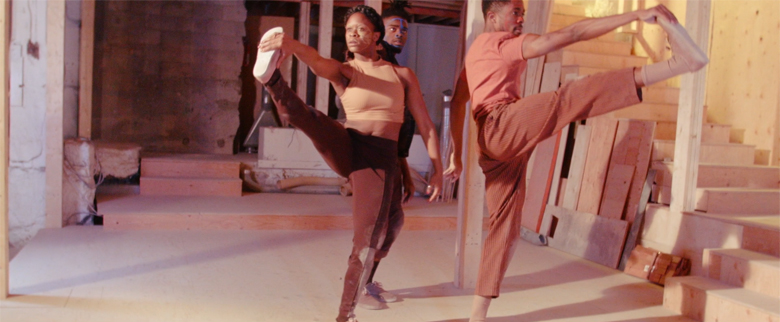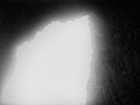“Do you know what red is? Or what good is? How about light? Or even day?”
Bonum [bo-NOOM], meaning “do for good anyways,” is a series of dream sequences between four dancers, choreographed and directed by Sabrina Naz Comanescu, and filmed and edited by Aran Wilkinson-Blanc. Two hands—spirits—cross and uncross, float around each other, mix red and blue. Introduced in Romanian verse by a narrator, the mythos of Bonum ensues; red and blue paint drips over the hands, crossed over each other in purview. Characters find themselves in a dreamworld cacophony of vibrantly cool and warm aggressors; synths, heavy beats, snare, steelpans, and silence. Filmed at Workshop Studios during construction, dancers move in the dust of drywall, among unfinished slabs of wood, stacks of storage Tupperware, air duct—in the underbelly.
Two prolific members of Calgary’s dance and film communities respectively, Comanescu and Wilkinson-Blanc have joined disciplines to make five films together in the last three years—two hands crossed in their own right. Bonum, their most challenging short film yet, is the first time Comanescu has stepped off set to direct behind camera, with plans to continue. Their next concept already in the works, Luma sat down with them to discuss the making of Bonum, and the phenomena of dance on film.
This interview has been edited for length.
LUMA: How did the idea behind Bonum develop?
Sabrina Naz Comanescu: I guess the story's pretty personal to me. I was in a moment in my life where I was noticing that a lot of good things were happening and, as they would become greater, it's funny how the challenges also increased. I was just seeing that all around me. Specifically with my mom—she's a big figure in the community really, she puts on a lot of events—and one event has just been growing, and it's becoming stronger and way more successful every year, and nothing but good is coming from this event. The challenges, petty little challenges have also grown too, and I would just kind of scratch my head like, ‘That's crazy that that happens.’ That's bound to happen in a way, this idea of like mo' money, mo' problems. There would be moments where I could see her be like, ‘Why am I doing this?’ And I'm like, ‘No, keep going.’
LUMA: Keep persevering.
SNC: Keep preserving. Don't just sit, don't just stop. Right now I'm on a committee for a festival, and it's crazy the challenges that we're facing that make me just want to be like, ‘Yeah right, I'm not doing this anymore.’ But what does that do for the community, what does that do for the festival? Nothing. So this idea of just being complacent, or choosing to be neutral and just stop, and not persevere through your problems, was what inspired the idea. Like, keep going, be vigilant, keep going. And then, as I had this idea, [The Festival Of Recorded Movement] (F-O-R-M) put a call out and I was like, ‘Hey, I have an idea, I want to shoot this regardless of getting in or not; let's just try." It worked out, they accepted us; it was history from there.
LUMA: What sort of dangers do you think complacency are attached to?... I ask this because my mom sent me an article this week about how the Internet makes it really hard to make social or political change because it just creates really loose connections with people. They're not very deep connections. You can't have a really deep uprising, ’cause no one really sees each other in person. You don't know who you're talking to.
SNC: Right.
LUMA: And so I'm thinking some kind of physical act, like with dance, where you're meeting with people, you're showing ideas, you're sharing each other’s energy, creates a really deep tie with which you could do stuff like convey a message about perseverance. Maybe it's easier with dance to make an idea come across or start a movement, a broader movement than with something that's more Internet-based. I just wanted to know what your thoughts were on that. Do you think dance has more of a potential to create change or to create movement of ideas?
SNC: Yes, I do think dance has the potential to create change for sure. I think it's one of those vehicles that can definitely spark conversation and I think that's one of the most important things in change—we have to talk about the issues that are bothering us, or we have to talk about the road blocks to see how we can get over them, around them, under them. And why not dance, why not have that be a way to spark that, to create that change, that ripple effect? I definitely think that it can be used. I don't think that we should forget about it in any way.
With Bonum, I knew this was gonna be super abstract. I even get feedback from people, they come up to me and they say, ‘Wow this is what I felt and thought.’ And [I’m] like, ‘That is cool. That has nothing to do with what I put on the storyboard,’ but nonetheless you're talking about something, right? You're conversing with me about something that you think needs attention. Whether it be personal or a greater community issue, this is great. Look, we're talking—now what?
Aran Wilkinson-Blanc: It also makes things more accessible for people, ’cause if you just want to sort of sit a bunch of people down and say, ‘Okay now we're gonna talk about energies.’ That doesn't really engage people, whereas something creative like dance it—involves them in more of an overall sense, and it doesn't feel like a lecture; it feels more like involvement.
LUMA: You can engage with more of your senses too because there's music happening, there's movement; there's an emotional exchange that you get to be a part of, which is more motivational than any sort of lecture... That whole YouTube aspect—making dance more open-sourced, available to anyone, even if they can't afford to buy a ticket for a show—makes it more accessible, but do you think that the recording alters the dance itself, takes away a living element to it?
AWB: I think it definitely changes the dance aspect, but I think that it doesn't really, necessarily impact the live performance because, by the time you actually start shooting and editing all that, it becomes a whole different medium.
SNC: I think—from a dancer’s point of view—I think capturing combinations and sequences and putting them on YouTube, that's fun and all. I find that sometimes it takes away a little bit. It kind of makes it seem a little bit too polished. Right now on YouTube, what's super popular is filming your combo from the class. You do it, and you put it up there, and I think it kind of falsely advertises what class is about. It kind of makes it seem like class is a performance space versus a learning space. So, in that respect, I'm not too thrilled about it. It's great for promoting. I know a lot of people know about my classes because I've put things out on YouTube, but. . . when I watch it, I go, ‘Wow, that's like a performance. That's a show.’ Is that really class though?
But then with Bonum, I think this was a really different approach than me asking Aran to come to one of my soca classes—which I do all the time. Bonum was really different because, from the jump, we were thinking, ‘Okay: camera angles, how can we convey this idea through the lens, and how can we shoot this to get this idea across and make it seem more dynamic,’ than just straight on, ‘Here's my combo.’
LUMA: Yeah, with Bonum you can see the camera moving in more similar ways to the dancers—you go behind different beams and you're moving with a hand cam around the dancers. I wanted to ask you, Aran, how has your way of filming dance changed as you've been working with these dancers over the last few years—have you become more active or more responsive?
AWB: It's sort of changed on two levels because, first of all, when I was doing the class documentation, the way I would shoot is like: you've got the medium, close, wide shots—a lot of choices for editing and all that. With those classes, Sabrina was always, "More wide," because it's more about documenting the whole class and the whole experience, as opposed to actually chopping it up in bits and pieces. With the first videos that we did together, again, it was more like, ‘Okay, this is the combo we're gonna do.’ It was, again, sort of more shooting a lot of different pieces and then putting it together and editing.
Bonum was the first time we actually got storyboards together and everything was planned out. Finally. And we started doing rehearsals with the camera to figure out, ‘Okay how will this actually integrate into the project?’ And then also from a technical level, this is the first time we did an actual steady cam for all those shots, so that really freed up the camera to be able to move around.
LUMA: I couldn't help but noticing you share the same surname with one of the narrators and the co-script writer. What was the script writing process like, and who is Sherban Comanescu?
SNC: Sherban Comanescu, yes, so that's my pops. I wanted to make this whole film very personal and so I wanted to sprinkle a little bit of Romanian in there. I just love the way the language sounds. I find it to be very beautiful. I love my dad's voice. I'm totally just fan girling out right now on my dad…
LUMA: It's very soothing.
SNC: And that's my own dad. And so the script writing process, that was me. I kind of just put that, all of that together on my own, but the first little bit that he read, he definitely edited that and kind of spell checked and made sure that things weren't too crazy, ’cause when I was writing, it was way out there. He kind of brought it in. The writing process was really just me trying to show the story without being too forward about it. Without being too matter-of-fact about it. This whole thing is so abstract, it's a dance film, so I wanted the text to reflect that as well.
LUMA: Yeah, that was one of my favourite parts—how it's so conversational... There’s a Romanian and then an English voice, and they’re all speaking really poetically, and whatever they say, you have to go back and watch it again ’cause it's how you decode the rest of the dance. . . What was it like working with a dancer who also ended up doing the music production?
SNC: So, first of all, this whole thing was a huge learning curve for me as a dancer, filmmaker, person. And being in a festival—this is my first festival—so I didn't know that you need the rights to music. ‘Hello, you can't just take a song and go with it!’ So I was working with a lot of music. I was getting very attached to it and then F-O-R-M was like, ‘FYI, you know, you can't just use this; you have to get permission.’You see what I’m saying? So time was ticking, like literally a month to go and I was like, there's no way. I was working with about four to five tracks. There's no way I was gonna get the rights in time and so I was like, ‘Hey, Aris.’
LUMA: ‘You do music, right?’
SNC: You do music. So it was kind of one of those things that was fashioned after necessity. We need to do this. Luckily, Aris is dope and makes great music for his personal work, so I felt super confident when he was on board to make the music for it. But it was great, it was very natural, because he's a dancer so he understands how to make music for this, how to make the music for this specific process. He's well-versed in dancehall and Afro-house and house and things like that, and we collaborated with those sounds and then I was also like, ‘Oh, jazz too. Please put a little bit of it in there.’ We tried to put some percussion in there, some cymbals, and things so it could reflect the movement. But it was smooth, it was a good process—it saved the day in the end.
LUMA: I love how also the soundtrack's so seamless, and works with a lot of silences... Could you talk a bit about your characters, and the style of dance?
SNC: There's four main dancers. Amazing dancers. Natasha Korney, Rodney Diverlus, Aristotle Nsungani, and Ajay Musodi. So, these guys are my muses. They're fantastic movers in Calgary. So fortunate to dance with two of them at Decidedly Jazz.
Character-wise, Natasha—to me—was the main. She was the human, she's us. And then there are two wolves, to me. I know sometimes when I say wolves to people, they're like ‘What?,’ but there's a story behind it. Rodney and Ajay are, they represent your good energy, your bad energy, the good wolf, the bad wolf. And then Artistotle, he is your complacent human being. And so my goal was to show how these two human figures, Natasha and Aris, react to good energy, bad energy, and who decides to be vigilant and who decides to be complacent and what happens to them in the end.
And dance-wise, I'm super inspired by dance hall, soca, house; any urban style really speaks to me, but I also have a really deep love for jazz and vernacular jazz movement. Being a dancer in the Decidedly Jazz Company, that work we do there definitely trickles into my personal work. So I just wanted to blend it all up basically and create something that was just so uniquely mine. Personally my touch on that.
LUMA: As to the lighting—there was a green scene, then some more warm, and more cool. Then at the beginning, we have the red and the blue paint and I'm wondering if the lighting is meant to reflect that sort of opposition? The warm, the cool, and the mixture of the two? Has the lighting sort of worked into that conceptually?
SNC: Yeah it is. Like the paint, I wanted to play with this yin-yang thing—good energy, bad energy—but I didn't want to do black and white, ’cause I was like, ‘Let's just be a little more abstract. Let's try something different.’ So red and blue, and in some of the scenes where I personally feel that—let's say the good energy is taking over or we're focused on that—I wanted it to be as warm as possible, but for instance in the—what I'm calling ‘the complacent scene’—between Aristotle and Rodney, I wanted that to be as cool as possible. That's when we have some glitching going on too in that scene.
LUMA: Yeah, I wanted to ask about that glitching. That sort of VHS-ization. I guess that's a new word…
[Laughter]
AWB: Well Sabrina came to me, actually on Instagram, sending me little shots and things and saying, ‘Can we do this? How about this? I like this effect.’ So years ago I had been playing around with digital glitching, and recently I've started to go back into that and I thought, ‘Okay, that was neat.’ But the more I thought about it, I thought, ‘Okay, it doesn't really work with the overall project,’ because the thing about digital glitching is it’s very prominent, and I didn't want the glitching to sort of drag you out of [the narrative] because it becomes more like the actual film itself or the visual plane becomes part of it.
So I thought, ‘Okay what about analog glitching?’ because I thought, ‘Okay, that works also with the overall themes that are going on with energies, and that whole dream sequence.’ More like things eroding and going backwards, so I proposed that. And basically we did that just by doing the footage—like, the nice clean footage—and then sticking it on a VHS cassette, and running it through again and again, and then recording it back to digital, and there you go.
SNC: Champ over here.
LUMA: You're a champ, Aran, yes. It's interesting the glitchy sort of VHS section makes it look a bit like paranormal, and then there's a lot of—almost like the movement of spirits. There's sort of… [does hand motion] I don't want to say snaky, but like spirit movements mostly.
SNC: Definitely those two guys, good wolf, bad wolf, like that's energy and that was a big part of our conversation in the studio. ‘How can your intention behind your movement be different than these two dancers?’—that's me speaking to Rodney and Ajay versus Natasha and Aris—‘And so think of energy, think of fluidity.’
LUMA: I wanted to ask you, Aran: you referred to some of the sets as being inspired by South Korean TV dramas. I want to know more about that, how that came about.
AWB: The Internet. Yeah, being able to stream. There are a lot of channels that are now streaming Korean programming. I've been watching them, and it's very interesting because one of the things I don't really like about ‘the movie’ and North American sort of cinematography, is that there's a lot of very flat looks to everything. So, look at everything; it's very grey. And there's no actual black, there's no actual white; everything's sort of in this murky zone. There's also something called the orange and teal colour scheme, which if you watch the Transformers films, everything's either orange or teal colour-wise, and it's all done in post production, so the whole shot is all green or teal, and I really don't like that.
When I started watching all these South Korean programs, just sort of out of curiosity to begin with, I noticed that they have a lot more punchy colors, and they're actually made from lighting techniques as opposed to just all the post. One of them's called Voice—it's sort of a police procedural. What's interesting, again, they use a lot of orange and teal colors, but it's the actual light that they're using, so it feels more organic to the image. So I wanted to really incorporate that into what we were doing with this project, ’cause this is the first time we really had control over our environment and sculpting it.
And actually in February, we're doing another dance video. With digital glitching. It's gonna be about movement, like with Bonum but with more analogue glitching. With this, we're actually taking the glitching and making it part of the film itself. A lot of the glitching has to do with movement and how the video codecs actually record movement. So I wanted to introduce the dance element and the movement element into it. So we have lots to discuss in a little bit.
Aran Wilkinson-Blanc and Sabrina Naz Comanescu will be debuting a new work titled Kept Progression at PARTICLE + WAVE Media Arts Festival on February 3, 2018 at Festival Hall in Calgary.
Sabrina Naz Comanescu is a dynamic member of the Calgary Dance Community through her work as an instructor, performer, choreographer and filmmaker. As a performer, Comanescu has worked with House of Dangerkat, The Bad Girls Club YYC, ILLFX Entertainment and currently dances with the Decidedly Jazz Danceworks professional company. She is also the current major force behind The Diversity Performing Arts Club of Calgary that “celebrates cultural diversity while promoting inclusion and respect for all,” and the founder and artistic director of Casa De Naz (CDN), established in 2012 to “excite and educate art hubs across Canada about the thriving Caribbean community in Calgary and the arts of the Caribbean as a whole.”
Aaron Wilkinson-Blanc is a Canadian multidisciplinary visual artist based in Calgary. He graduated from the University of Calgary with a BFA in photography and has continued in that field, along with those of video, computer animation and graphic design. The high level of technological mediation inherent in his practices leads him to seek out collaborations with other artists and work on projects that incorporate different ideas and perspectives. He attempts to build on the creative opportunities technology affords him, without allowing them to dictate the form or substance of his work. In this, he explores the relationship between people and their constructed interactions.

